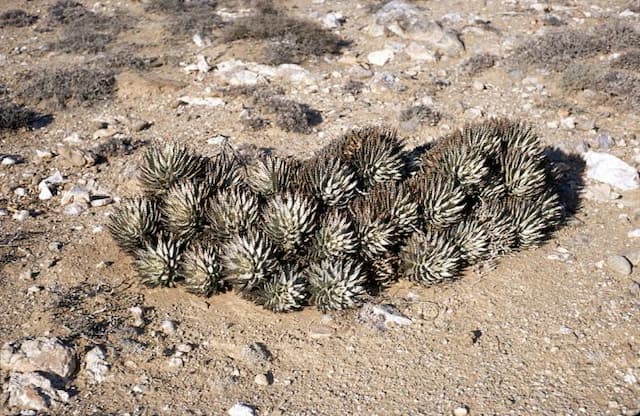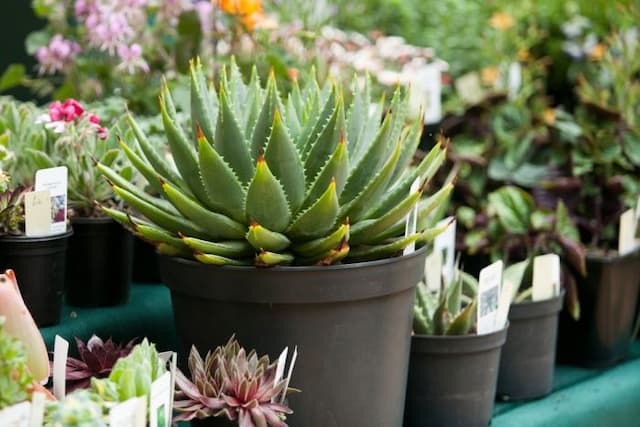Red Hot Poker Kniphofia ensifolia

ABOUT
Commonly known as Red Hot Poker or Torch Lily, this plant is characterized by its striking and bold appearance. The foliage forms a grassy clump of narrow, arching leaves that typically boast a rich green hue. The leaves often have a sword-like shape and create a dense cluster at the plant's base. The most distinctive feature of the Red Hot Poker is its flower spike. The blooms are densely packed on a tall spike, showcasing a gradient of colors ranging from red at the top, transitioning to orange, and finally to a yellowish hue towards the bottom. The flowers are tubular and are beloved by hummingbirds and other pollinators which are attracted to their vibrant colors and sweet nectar. These spikes extend above the foliage and create a dramatic display that can add an exotic flair to any garden space. The contrast between the vertical flower spikes and the horizontal leaf blades provides a strong architectural element to the plant’s form. The beauty of the Red Hot Poker lies in its vivid flowers and the textural contrast they bring to the garden landscape.
About this plant
 Names
NamesFamily
Asphodelaceae
Synonyms
Red Hot Poker, Torch Lily, Poker Plant
Common names
Kniphofia ensifolia.
 Toxicity
ToxicityTo humans
Information on Kniphofia ensifolia, commonly known as Red Hot Poker, and its toxicity to humans is not widely documented or well-established in toxicology databases. Generally, Red Hot Poker plants are not considered highly toxic to humans. However, like many other plants not commonly ingested, they may cause mild stomach upset or skin irritation in some individuals if they come into contact with the skin or are ingested. It is always advisable to exercise caution and prevent ingestion of ornamental plants.
To pets
Red Hot Poker (Kniphofia ensifolia) is not widely recognized as a toxic plant to pets such as dogs and cats. There is limited information on its toxicity, but it is generally not listed as a plant of major concern in terms of pet poisoning. Nevertheless, it is still possible that pets may experience mild gastrointestinal upset if they ingest parts of the plant, including symptoms like vomiting or diarrhea. To ensure pet safety, it is best to prevent pets from chewing on or ingesting any part of ornamental plants.
 Characteristics
CharacteristicsLife cycle
Perennials
Foliage type
Evergreen
Color of leaves
Green
Flower color
Orange
Height
2-3 feet (60-90 cm)
Spread
2 feet (60 cm)
Plant type
Herb
Hardiness zones
6
Native area
South Africa
Benefits
 General Benefits
General Benefits- Ornamental Value: The plant, commonly known as Poker Plant, adds aesthetic appeal to gardens with its striking flower spikes and evergreen foliage.
- Attracts Pollinators: The vibrant flowers of Kniphofia ensifolia draw in beneficial pollinators, such as bees and hummingbirds, which are essential for pollination.
- Drought Tolerance: Once established, the Poker Plant is quite drought-resistant, making it suitable for xeriscaping or in regions with water scarcity.
- Low Maintenance: It requires minimal care once settled in the right environment, making it a favorable choice for gardeners of all skill levels.
- Erosion Control: Its root system can help stabilize soil and reduce erosion on slopes or in areas prone to losing topsoil.
- Long Blooming Period: Kniphofia ensifolia has lengthy blooming periods that ensure color in the garden for extended times.
- Versatility in Landscape Design: The plant can be used in various design schemes, including borders, mass plantings, and as a focal point due to its unique flowering structure.
- Perennial Lifespan: As a perennial, it will return year after year, providing long-term interest in the garden.
 Medical Properties
Medical PropertiesThis plant is not used for medical purposes.
 Air-purifying Qualities
Air-purifying QualitiesThis plant is not specifically known for air purifying qualities.
 Other Uses
Other Uses- Kniphofia ensifolia, commonly known as Poker Plant, can be used as a source of nectar for bees and hummingbirds, attracting these pollinators to the garden.
- The tall and striking flowering stalks of Poker Plant can be used in cut flower arrangements, adding height and color to bouquets.
- The leaves of Poker Plant can be used in composting to add green matter that helps in creating rich and nutritious compost.
- In some cultures, Poker Plant leaves may be used to thatch roofs or create utility baskets, utilizing the plant's fibrous nature.
- The Poker Plant can serve as a natural fence when planted in a row or hedge, providing a living boundary that can dissuade small animals from crossing.
- As the Poker Plant is fire-resistant, it can be planted in fire-prone areas as a part of fire-safe landscaping to create defensible space around structures.
- The plant can be used in xeriscaping, a landscaping method that reduces or eliminates the need for irrigation, due to its drought-tolerant properties.
- The dried flowering stalks of the Poker Plant can be used for crafts or as natural decorative elements in dried floral arrangements.
- When grown in coastal areas, Poker Plant can help stabilize sand dunes and prevent erosion with its root system.
- Poker Plant can provide educational opportunities for schools or community gardens, teaching about pollination and plant growth habits due to its distinctive flowering pattern.
Interesting Facts
 Feng Shui
Feng ShuiThe Red Hot Poker is not used in Feng Shui practice.
 Zodiac Sign Compitability
Zodiac Sign CompitabilityThe Red Hot Poker is not used in astrology practice.
 Plant Symbolism
Plant Symbolism- Attraction: The bright, fiery colors of the Red Hot Poker's flowers are reminiscent of flames, making it a symbol of attraction and magnetism.
- Vibrancy: The vivid hues of Kniphofia ensifolia signify vibrancy and the essence of life, as well as joy and positivity.
- Courage: This plant stands tall and firm, which often represents courage and the ability to stand your ground.
- Standing out: The Red Hot Poker is unique in appearance, thus symbolizing individuality and the importance of being distinct or standing out from the crowd.
 Water
WaterRed Hot Poker plants, including Kniphofia ensifolia, should be watered deeply, allowing the soil to dry out slightly between waterings. During active growth in the spring and summer, water approximately once a week, providing about one inch of water each time. In well-drained soil, ensure that the water reaches the roots without leaving the soil waterlogged. Cut back on watering in the fall as the plant begins to go dormant, supplying water only if there is a prolonged dry spell. In colder months, water sparingly, just enough to prevent the soil from becoming bone dry, as the plant is not actively growing and excess water could lead to root rot.
 Light
LightRed Hot Poker thrives in full sun to partial shade, with a preference for a location that receives at least six hours of direct sunlight each day. The ideal spot for Kniphofia ensifolia is an area that offers bright, unfiltered sunlight, as ample sun exposure encourages vibrant blooms and healthy growth. However, in regions with extremely hot summers, some afternoon shade can help protect the plant from excessive heat stress.
 Temperature
TemperatureRed Hot Poker plants are tolerant of a wide range of temperatures but grow best in conditions where temperatures range between 50°F and 75°F. They can survive minimum temperatures down to around 0°F, making them suitable for growth in USDA hardiness zones 5 through 9. However, they should be protected from extreme cold with mulch or coverings to ensure their survival through harsh winters.
 Pruning
PruningPruning Red Hot Poker plants involves removing spent flower spikes to encourage additional blooms and maintain a neat appearance. After flowering, cut the stalks down to the base of the plant. In early spring or late fall, remove any dead or damaged foliage to promote healthy growth. Pruning is typically done once flowering has ceased or as needed to remove damaged leaves.
 Cleaning
CleaningAs needed
 Soil
SoilRed hot poker plants thrive in well-drained soil with a pH between 6.0 and 7.0. A mixture of garden soil, compost, and sand ensures proper drainage. Regular feeding with a balanced, slow-release fertilizer is beneficial.
 Repotting
RepottingRed hot poker plants generally need repotting every 2 to 3 years to refresh the soil and accommodate their growing root system.
 Humidity & Misting
Humidity & MistingRed hot pokers prefer lower humidity levels and are tolerant of dry air conditions. They perform best in environments that mimic their native, arid habitats.
 Suitable locations
Suitable locationsIndoor
Place red hot pokers in bright light and well-draining soil.
Outdoor
Plant in full sun, well-draining soil, and protect from extreme cold.
Hardiness zone
5-9 USDA
 Life cycle
Life cycleKniphofia ensifolia, commonly known as Red Hot Poker, begins its life cycle with seed germination, which is influenced by temperature, light, and moisture levels. Following germination, seedlings establish themselves with a basal rosette of narrow, grass-like leaves. As the plant matures, it enters a vegetative growth phase where it develops strong roots and foliage, preparing for flowering. Flowering typically occurs during the summer when tall, upright flower spikes emerge, displaying tubular flowers that transition from red to orange to yellow. After pollination, usually by birds or insects, flowers develop into capsule-like fruit containing seeds. The plant may die back in colder conditions but can survive mild winters and regrow from the base in the following season.
 Propogation
PropogationPropogation time
Spring-early summer
Propogation: Kniphofia ensifolia, commonly known as Red Hot Poker, is typically propagated by division, which is best done in the spring or early summer to allow enough time for the plants to establish before the cooler weather sets in. To propagate by division, carefully lift the plant from the ground using a garden fork, ensuring to keep a good amount of root and soil intact with the clump. Gently separate the crowns by hand or with a sharp knife, making sure each section has at least one growth point or shoot. Replant the divisions immediately at the same depth they were growing at before, space them about 18 inches (approximately 45 centimeters) apart to allow for adequate air circulation and growth. Water the new divisions thoroughly after planting to help establish them. This method is advantageous as it helps rejuvenate older clumps that may have become woody and less floriferous over time, encouraging more vigorous growth and blooming.









